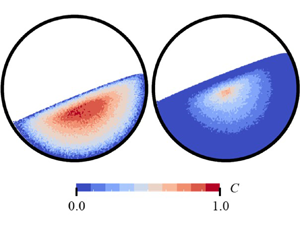Published online by Cambridge University Press: 24 January 2024

In this work, smoothed particle hydrodynamics (SPH) is employed to investigate the segregation evolution in granular flows. We first provide the Lagrangian description-based governing equations, including the linear momentum conservation and the segregation–diffusion equation. Then the hybrid continuum surface reaction scheme is introduced to formulate the concentration-related inhomogeneous Neumann boundary condition on the free and wall surfaces. We follow a two-stage strategy to advance boundary particle searching and normal direction identification. Moreover,  $C^1$ consistency is considered based on the Taylor series to obtain accurate segregation flux gradient along the boundary. Our SPH model is validated with a shear box experiment. The model is then applied to investigate the segregation mechanism in bidisperse-sized granular flows in a rotating drum.
$C^1$ consistency is considered based on the Taylor series to obtain accurate segregation flux gradient along the boundary. Our SPH model is validated with a shear box experiment. The model is then applied to investigate the segregation mechanism in bidisperse-sized granular flows in a rotating drum.